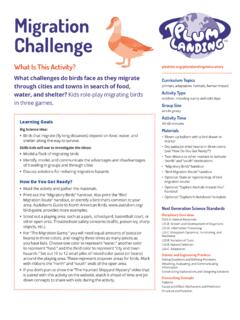Transcription of INVENTION—MAKING THE WORLD A BETTER PLACE
1 INVENTION MAKING THE WORLD A BETTER PLACEFOR 9- TO 12-YEAR-OLDS IN AFTERSCHOOL PROGRAMSin collaboration with/ S 4 GZK NUYZ UL *KYOMT 9W[GJ )NKIQ U[Z ZNKYK IUUR GIZO\OZOKY Dear Afterschool Educator:The Lemelson Foundation is delighted to bring you the Invent It, Build It guide. It builds on the rich resources of Design Squad and Lemelson-MIT InvenTeams to engage young people ages 9 to 12 in the creativity and possibility of invention. The guide s six invention challenges emphasize teamwork, creative problem solving, and how invention improves people s lives. The activities reach young people at a time in their lives when they are still intrigued by the WORLD around them. Our goal is to spark their investigative spirit, promote creativity, help them think through problems, and express their ideas through building things. This process stimulates young people s interest in math, science, and engineering. It also connects the process of invention to their everyday lives and to a broad range of careers and social by Jerome Lemelson, one of America s most prolifi c inventors, the Lemelson Foundation sparks, sustains, and celebrates innovation and the inventive spirit.]]
2 Its programs in the and in developing countries support invention-led economic, social, and environmentally sustainable development. The Foundation works with partners to recognize and celebrate accomplished inventors, provide fi nancial and mentoring support to grassroots inventors, offer hands-on opportunities that enable young people to develop their budding scientifi c curiosity, and disseminate technologies that improve people s this spirit, we encourage you to use the Invent It, Build It guide to bring invention and engineering to life for young people and inspire them to investigate and solve challenging problems. Together, let s help the next generation of inventors make the WORLD a BETTER PLACE !Sincerely,Dorothy Lemelson Julia Novy-HildesleyChair Executive Squad and Lemelson-MIT InvenTeams have teamed up to bring you six hands-on challenges designed to spark the inventive spirit of kids aged 9 12.
3 Whether you re running an afterschool program, workshop, or event, these challenges are a fun way to bring invention to life for kids, get them thinking like inventors and engineers, and show them how invention improves people s lives. INTRODUCTIONHow to Use This Guide 2 Talking with Kids about Inventing 4 Introducing the Design Process 6 Setting Up an Invention Club 7 INVENTION CHALLENGESC onfetti Launcher 8 Invent a device to launch a big cloud of Game 13 Invent a game that gets everyone up and Holder 18 Invent a holder for six cans that s animal-safe, sturdy, convenient, and easy to Shelter 23 Invent a sturdy shelter that s easy to Carrier 28 Invent a way for someone using crutches or a wheelchair to carry all their a BETTER WORLD 33 Invent solutions for needs found in daily life.
4 APPENDIXKid Inventors (tear-out poster) 37 The Design Process (tear-out poster) 39 Education Standards 41 Invention Resources 42 Sources for Materials 43 Related PBS Resources 44 TABLE OF CONTENTSC ompetition plus engineering equals fun! Design Squad gets kids thinking like engineers and shows them that engineering is fun, creative, and something they can do. Watch it on PBS and visit the Web site to get episodes, games, 35 hands-on challenges, and much , here we come! Through design challenges, educational resources, and grant programs, InvenTeams engages kids in invention, empowers them to problem solve, and encourages an inventive culture in schools and a New Generation of Inventors2 The guide s challenges take about an hour, use readily available materials, give kids many ways to succeed, and are aligned with national science and technology standards.
5 You can use them in a:one-time session like a workshop or event. Every challenge can be done as a stand-alone of sessions like an invention club or an afterschool science or engineering program. Want to start an invention club? See page GET STARTEDRead the leader notes. Found at the beginning of each challenge, they ll help you understand how to prepare for and run a session. Try the activity yourself. A practice run will help you fi gure out the best way to introduce the activity and anticipate potential problems your kids may run the challenge sheet. This handout for kids a cartoon strip featuring Design Squad host Nate Ball presents the problem to solve. It also provides the context for the challenge, questions to help kids brainstorm design ideas, and tips for building and the room. Set the stage for creative thinking, and get kids excited about invention. Post the tear-out invention posters found in the appendix. Also, Invention Resources (page 42) lists Web sites that feature wacky inventions, inspiring quotes about invention, and interesting profi les of inventors.
6 Visit the Web sites, fi nd items that you like, print them out, and post them around the TO USE THIS GUIDEI nvention appeals to anyone who loves using his or her ingenuity to problem solve and make a difference in the notes pageKids activity handout3TO LEAD A CHALLENGEN ever led an invention activity? Don t worry! The leader notes give you all you need to facilitate a session. The leader notes are divided into the following sections:The invention challenge Presents the goal for the session and the steps involved in running the challenge. Each challenge is designed to help kids (who work in groups of two or three) understand that inventors look for ways to improve people s ahead of time Lists things to do to get ready for the activity Gives kids an opportunity to practice a particular inventive thinking skill ( , improvisation, fl exibility, and visualization) that they ll use more extensively as they tackle the session s the challenge Provides an attention-grabbing story for you to read aloud.
7 The story gives kids a real- WORLD context for the challenge s problem as well as a sense of relevance, purpose, and meaning for their own design ideas Helps kids think about different ways to meet a challenge. Build, test, and redesign Lists issues that might surface during a challenge and suggests strategies to use with kids who face these issues. Discuss what happened Provides questions (and answers) that review the activity s key science and engineering concepts, helping kids refl ect on the design process and how the challenge relates to some more Presents extension activities that reinforce and expand the experiences kids have had in a FOR FACILITATING OPEN-ENDED CHALLENGEST here are multiple ways to successfully tackle a challenge. One solution can be just as good as another. Help kids see that the challenges are not competitions. Instead, they re opportunities to unleash an individual s ingenuity and kids feel stuck, have them describe why they think they got the results they did.
8 Ask questions rather than telling them what to do. For example, ask: Why do you think this is happening? or What would happen or What is another thing you could try? When something s not going as desired, encourage kids to try again. Have them compare their design to other kids designs. Remind them that problems are opportunities for learning and for using creative thinking. Have kids come up with several ways to solve a problem before they move ahead with an a design doesn t work as planned, encourage kids to try again. Setbacks often lead to design improvements and , ME? AN INVENTOR?Yes! People from every corner of the WORLD , of different ages, with different levels of education invent by identifying problems, pursuing ideas, and developing new solutions. The key to inventing is identifying a need and devising an original solution. Maybe a BETTER question is, Is there anyone who isn t an inventor? Let kids know that everyone has the capacity for invention.
9 We all solve problems through inventive thinking, whether it s fi guring out a way to prop open a window, stay dry in a rainstorm, or build a playhouse from scrap materials. Creative problem solving, improvisation, fl exibility, and tinkering drive the inventive spirit. WHAT S AN INVENTION? Let kids know that an invention is a useful creation that didn t exist before. Round out their understanding of invention by sharing the characteristics below. An invention usually fi lls a need or solves a problem. Inventions often make the WORLD a BETTER PLACE . Inventions can be things ( , a cell phone or backpack) as well as ideas ( , a new method for tying a knot, or a story).An invention often makes something BETTER ( , faster, stronger, cheaper, easier, safer or more effi cient, attractive, useful, accurate, fun, or productive). But as long as it s a new way to do something, it s still invention even if it isn t necessarily BETTER than what existed INVENT?
10 Inventing is a process. It starts with a need and ends up with something new the actual solve problems: Inventors are skilled at spotting ways to improve a situation or process. The activities in this guide help kids develop solutions to problems by applying the design process. To improve our WORLD : Imagine how different our lives would be without inventions, such as computers, refrigerators, electricity, plastic, and medicine. The activities in this guide show how inventions improve things at home, at school, in the community, and in the enjoy the creative process: Invention involves both thinking and doing. The activities in this guide help kids become involved in the process of thinking about a problem and then doing something about it. Because they create their own solutions, kids get excited about the process of WITH KIDS ABOUT INVENTIONS BY KIDSEven people with very little training can be inventorsEarmuffs (Chester Greenwood, age 15)Makin Bacon a quick, healthy way to cook bacon (Abigail Fleck, age 8)Popsicles (Frank Epperson, age 11)Fantasy baseball game with trading cards (Dustin Satloff, age 10)Sifting shovel for separating soil from leaves (Kaileigh Kirton, age 11)Helmet for sailors (Palmer Rampell, age 15)The cathode ray (TV) tube (Philo Farnsworth, age 14)Glow-in-the-dark writing pad (Rebecca Schroeder, age 10)Braille alphabet for the blind (Louis Braille, age 12)Crayon holder for broken crayons (Cassidy Goldstein, age 11)5 INVENTORS AND ENGINEERS ARE SIMILAR IN MANY WAYSE ngineering is a process for developing solutions to problems.





